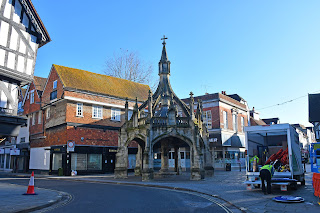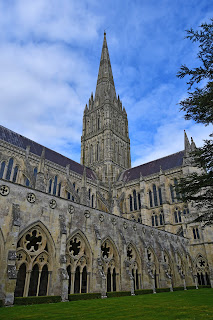Salisbury, Stonehenge, and Old Sarum
We arrived at the train station in Salisbury in the evening, so we quickly checked in and ate dinner. As my friend had never been to the UK before, I thought it would be a perfect opportunity to immerse him in the local culture: not only did we have dinner at the local Wetherspoons, we stayed the night in the adjoining King’s Head Inn Wetherspoon. Before going to sleep, we made a quick excursion to Salisbury Cathedral, which was beautifully lit up and peaceful (I resisted a few disgruntled calls to be spontaneous and just walk in any direction for an hour).
The next
day, my friend and I woke up at seven and after eating a full English breakfast
(well, a vegetarian one in my case), we made a short trip around Salisbury. Passing
by Poultry Cross – under the ornate buttresses of which, one would think,
poultry used to be sold – we visited Guildhall Square, before walking down
again towards the Cathedral and the Cathedral Close. A number of old and
presumably very expensive buildings surround Salisbury Cathedral, among them Mompesson
House, Arundells (the former house of Edward Heath), and two regional museums. In
the daylight, we could also make out more clearly the horde of statues on the
Cathedral’s walls. Some statues have lost their heads throughout the ages,
while some pedestals are completely empty, perhaps awaiting the canonisation of
new saints.
A little
after ten o’clock, our entire four-person crew boarded the first bus to
Stonehenge, which departs hourly from several places in Salisbury and takes
about half an hour. When we arrived, we decided against taking the tourist bus
from the entrance to the monoliths, and instead walked along the
barrow-littered fields, where burials took place for millennia. I had been to
Stonehenge once as a child and truth be told, it is somewhat smaller than I
remember it. However, the grandeur of the landscape impressed me much more this
time, as I realised just how much of the surrounding area was associated with Stonehenge.
The bus
back to Salisbury from Stonehenge went past Old Sarum, a massive moated hill
that was once home to a walled city. Very much neglected in comparison to
Stonehenge, Old Sarum seemed almost abandoned and eerily giant. From the
southern side of the walls, we could see Salisbury Cathedral off in the
distance, and from the north, we peered down onto the foundations of its
predecessor. The cathedral was moved in the early 1200s when the clerics lost
patience with its windy and remote location.
The very
next tourist bus bound for Salisbury picked us up where the last one dropped us
off just an hour earlier, and we made it back to the centre in good time.
There, we finally visited the inside of Salisbury Cathedral, the sheer size of
which is perhaps its most impressive feature. The Cathedral also houses one of the
four surviving exemplars of the original Magna Carta (two others are to be
found at the British Library and one at Lincoln Castle). Amazingly, the
document’s 3,600 words all fit onto one piece of parchment.
Our last
stop in Salisbury was the Church of Saint Thomas, which is known for its 15th
century painting of the Last Judgement. Reportedly the largest in the UK, it is
also known as the “Doom Painting” and has a bizarre history. It was whitewashed
in 1593 as part of the Protestant Reformation, but rediscovered in 1819, after
which it was whitewashed once more. Its final restoration only came in 1881.
We left Salisbury late in the afternoon and returned to Oxford just in time for dinner and a good night’s rest.




















































































Comments
Post a Comment